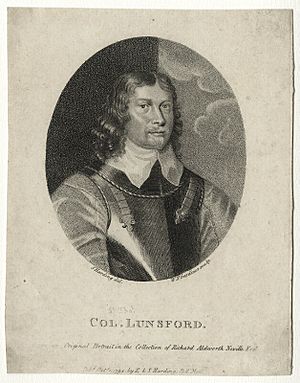Thomas Lunsford facts for kids
Quick facts for kids
Thomas Lunsford
|
|
|---|---|

Print of Sir Thomas Lunsford published in 1794
|
|
| Member of the Virginia Governor's Council | |
| Lieutenant of the Tower of London | |
| In office 1649-1651 |
|
| Personal details | |
| Born | c. 1610 Wilegh, Sussex, England |
| Died | c. 1653 near Williamsburg, Virginia |
| Resting place | Rich Neck, Virginia |
| Spouses | Anne Hudson (d. 1638) Katherine Neville(d. 1649) Elizabeth Wormeley Kemp |
| Children | 4 daughters |
| Parents |
|
Sir Thomas Lunsford (born around 1610, died around 1653) was an important figure during the English Civil War. He was a Royalist colonel, meaning he supported King Charles I. After the war, he moved to the Virginia Colony in 1649. There, he took on important roles, gained land, and lived out his final years.
Contents
Early Life and Family History
Thomas Lunsford was born in Wilegh, Sussex, England. His father was also named Thomas Lunsford. His mother, Katherine, was the daughter of Thomas Fludd, who managed war finances for Queen Elizabeth I. Katherine's brother was Robert Fludd, a famous scholar.
Thomas Lunsford was the third son in his family and had a twin brother named Herbert. Both Herbert and another brother, Henry, also became officers for the Royalist side. Sadly, Henry was killed in July 1643 during a battle in Bristol.
Early Challenges and Time in France
From a young age, Lunsford was known for being a bit rebellious. In 1632, he faced charges for hunting deer on land belonging to a relative, Sir Thomas Pelham. Later, in 1633, he was involved in a serious incident with Pelham.
He was sent to Newgate Prison but managed to escape in 1634. Even though he was injured, he fled to Europe. He joined the French army and became a colonel. Because he didn't appear in court back in England, he was fined a large sum of money and declared an outlaw.
Family Life and Marriages
Sir Thomas Lunsford was married three times. His first wife was Anne Hudson, who passed away in 1638. They had one son who died very young.
In 1640, he married Katherine Neville. They had three daughters together before Katherine died in 1649. His third wife was Elizabeth Wormeley Kemp. She was the daughter of Christopher Wormeley, who had moved to Virginia. Elizabeth was also the widow of Richard Kemp, a member of the Governor's Council in Virginia. Thomas and Elizabeth had one daughter.
Supporting the King in the English Civil War
In 1639, Lunsford returned to England. King Charles I gave him a pardon, forgiving his past actions. Lunsford then joined the king's army to fight against the Scots.
In 1640, during a trip to Scotland, Lunsford led a group of soldiers. His group fought in the Battle of Newburn on August 28, 1640. They tried to defend a river crossing but were eventually defeated by Scottish forces.
A Royalist Officer's Role
On December 22, 1641, King Charles I made Lunsford the Lieutenant of the Tower of London. This was a very important position. However, people in London were not happy about this choice. The next day, they sent a petition to the House of Commons (part of the English Parliament) asking for his removal.
Because of this pressure, the king removed Lunsford from the post on December 26. The next day, Lunsford was called to Parliament for questioning. This event added to the king's growing unpopularity.
The king honored Lunsford by making him a knight on December 28. He also put Lunsford in charge of a special royal guard at the Palace of Whitehall. On January 4, 1642, Sir Thomas went with the king in an unsuccessful attempt to arrest five members of the House of Commons.
Later, on January 13, Lunsford was arrested. He was accused of being part of a plan to take control of a military storehouse. He was released in June and took part in several battles. He was captured at the Battle of Edgehill in October 1642 and held in Warwick Castle. He was set free in May 1644.
End of the War and Journey to Virginia
Sir Thomas was captured again in December 1645 during the Siege of Hereford. He remained a prisoner until 1648. On August 7, 1649, he received permission to move to Virginia with his wife and family.
Life in Virginia and Passing Away
Lunsford and his daughters arrived in Virginia in 1649. In 1650, he was appointed to the Council of State, a group of important advisors to the governor. He officially took office in 1651.
Soon after arriving, Lunsford gained ownership of over 3,400 acres of land. This land was located near Portobago Bay on the Rappahannock River. It was across from a Native American settlement. Usually, people received land based on how many people they paid to bring to Virginia. They also had to improve the land. Lunsford also owned land in Northumberland County.
After the colony's secretary, Richard Kemp, passed away, Lunsford married Kemp's widow, Elizabeth Wormeley. He then lived at Kemp's former home, Rich Neck Plantation. Lunsford held the rank of lieutenant-general in the Virginia militia. He passed away around 1653 or 1656.
Sir Thomas Lunsford's Legacy
Three of Lunsford's daughters, Elizabeth, Phillippa, and Mary, eventually returned to England. However, his daughter Catherine stayed in Virginia. In 1670, Catherine married Peter Jennings, who was the colony's attorney general. She also claimed her late father's land on Portobago Bay.
At that time, the Portobago Bay land was set aside for the Portobago and Nanzattico Native American tribes. But Catherine Wormeley was allowed to keep the land as long as the native peoples were not disturbed. After Peter Jennings died, Catherine married Ralph Wormeley Jr. In 1680, Ralph Wormeley Jr. officially gained ownership of the former Nanzattico land.

